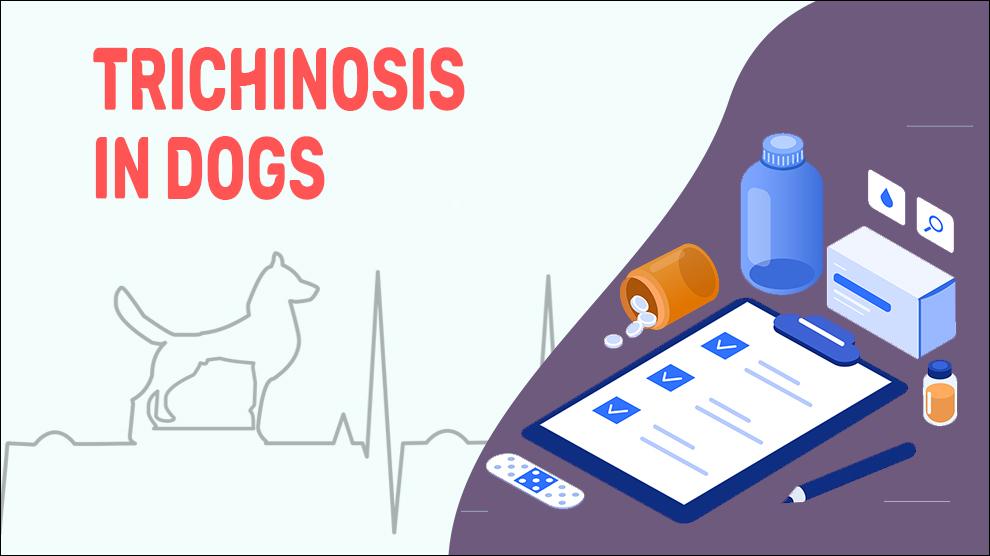What Is Trichinosis In Dogs?
Trichinosis (Trichinellosis) is a parasitic disease caused by the nematodes of the Trichinella genus particularly Trichinella spiralis (pork worm). Though often unrecognized, Trichinosis is a significant disease for hundreds of years. Trichinella species are responsible for the zoonosis that is widely distributed, including the tropics, and arctic and temperate lands. Almost all mammals (including dogs) are prone to infection and humans seem to be particularly susceptible to developing clinical disease.
Despite having a low prevalence globally, the zoonotic nematode remains a significant foodborne zoonosis to prevent its incursion into the food chain is really hard, and its epizootic nature. Recent phylogenetic and genomic analyses suggest that the 11 known Trichinella species are distinguished into two clades by occurrence or non-occurrence of third-stage encysted larvae that have parasitized skeletal muscle tissues.
When meat containing infective third-stage larvae is consumed by the dog the parasite life cycle begins with the enteral phase. The encapsulated cyst wall after digestion in the acid-pepsin environment of the stomach releases the Larvae (1 mm in length). Larvae navigate fastly to the intestinal lumen, where the columnar epithelium cells are parasitized. In over 10 to 28 hours, four molts occur in the epithelium of the small intestine concluding the development of mature adult female and male worms. Engorged female worms release newborn larvae (first-stage) that kick off the infection’s systemic phase as they infiltrate the gut wall, pass through the lymphatics, and ultimately via the thoracic duct, enter the blood circulation. Newborn larvae are scattered in capillary beds all through the body and eventually parasitize striated skeletal muscles. Within 15 days after they enter the muscle, the larvae molt encapsulate, and develop into infective third-stage larvae.
Symptoms Of Trichinosis In Dogs
- Diarrhea, with or without blood or mucus
- Abdomen distension
- Adult worms in stool
- Myalgia – Muscle pain
- Muscle inflammation
- Muscle stiffness
Treatment Options For Trichinosis In Dogs
Deworming medication (anthelmintic) will be recommended by your veterinarian based on the extent of infestation together with the proper administration protocol.
Stool (fecal) examinations should be conducted 3 to 5 times during the first year of life and after that, yearly once or twice is more than enough.
Oral deworming drugs: Piperazine, pyrantel, fenbendazole, moxidectin, and milbemycin.
Home Remedies For Trichinosis In Dogs
Trichinosis infections are never going to go away on their own. While they are treatable, however, keep in mind that the best way to protect your pets against parasites is to using parasite preventatives.
How To Prevent Trichinosis In Dogs?
- Initial treatments should be given to all puppies (> 3 weeks of age)
- It is good to perform fecal tests yearly for adult dogs
- Follow dog worms preventive medication monthly
- Try annual dewormer protocol for dogs as recommended by your vet
- In your home, maintain good sanitary and hygienic conditions; periodically clean up your backyard. This includes restricting indoor exposure to fecal matter, contaminated soil, and/or host animals
- Whatever may be the lineage or age, upon acquisition of new dogs makes sure to follow a dewormer immediately or follow your veterinarian's directions
Affected Dog Breeds Of Trichinosis
There is no breed predisposition. Puppies are overrepresented.
Causes And Types For Trichinosis In Dogs
1. Causes:
An adult dog gets parasites through consuming contaminated pork products.
Eating or smelling feces from infected pork.
2. Types:
- T. Spiralis - Found worldwide
- T. Pseudospiralis – Worldwide
- T. Native - Arctic region
- T. Nelson - Africa
- T. Britovi - Western Asia and Europe
- T. Papua - Papua New Guinea and Thailand
3. Mortality:
Trichinella species worms are fatal if left untreated. Death may occur in 4- 6 weeks after the initial infection.
4. Diagnosis:
- A complete blood count (CBC), chemistry profile
- Urinalysis
- Fecal flotation
5. Prognosis:
Dogs with a mild infestation, a quick recovery can be certain, once treatments have begun. When there is a chronic infestation, it may take a longer time for your dog to recover.
Properly adhere to the veterinarian's treatment protocol and provide medications as recommended. The medications are usually repeated in 3-4 weeks to break the life cycle so that dogs don't just get it again from the same source.
When To See A Vet For Trichinosis In Dogs?
Contact your vet right away, if you notice any of the following:
- Diarrhea, with or without blood or mucus
- Abdomen distension
- Adult worms in stool
- Myalgia – Muscle pain
Food Suggestions For Trichinosis In Dogs
- Offer bland meals for 1 or 2 days
- Whole, unprocessed foods or Nutrient-dense and biologically suitable foods
- 2 part cooked rice + 1 part boiled lean hamburger
- 2 parts rice or cooked macaroni + One-part boiled egg or cottage cheese
- Pumpkin seeds, carrots, Bananas, Apples, Seaweed
- Probiotics (yogurt, kimchi, kefir with live cultures, fermented vegetables)
Conclusion
Nematodes are infectious to humans and other animals. They pose a significant risk to humans but they are not directly transmitted to humans as they need an intermediary host, like a flea, or from direct contact with the contaminated soil or feces from infected animals. Washing your hands regularly is the best preventive action to avoid Trichinella infection.

















